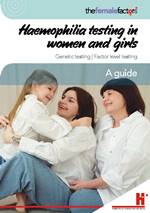Don’t bleeding disorders just affect males?
No. All bleeding disorders can affect females as well as males.
Which bleeding disorder most commonly affects women?
Von Willebrand disease (VWD) is the most common bleeding disorder worldwide. It affects males and females equally, though women tend to have the added issue of heavy bleeding with menstruation (heavy periods) and sometimes after giving birth. For more information click here.
Can females have haemophilia?
Many girls or women who carry the gene alteration causing haemophilia do not have symptoms of a bleeding disorder.
But around 20-30% have reduced factor levels and bleeding problems associated with haemophilia. In the past they were described as ‘symptomatic carriers’.
- If their factor levels fall in the range for mild haemophilia (5-40% of normal clotting factor), they are now recognised to have mild haemophilia.
- In some very rare cases girls and women have particularly low factor levels causing them to have moderate or severe haemophilia.
- Some women with factor levels at the lower end of normal (40-50%) also experience abnormal bleeding. If further investigation indicates this bleeding is related to a factor VIII or factor IX deficiency, they will be treated as having haemophilia but diagnosed as a ‘symptomatic haemophilia carrier’.
NB. In genetics, all females who have the gene alteration causing haemophilia are described as ‘carriers’.
For more information click here.
For more about diagnosing haemophilia in women and girls, bleeding symptoms (and why your symptoms might be different to others in your family), factor level and genetic testing, read our booklets:

Haemophilia testing in women and girls: a guide (shorter/simpler)

Haemophilia testing in women and girls: your questions answered (comprehensive)
